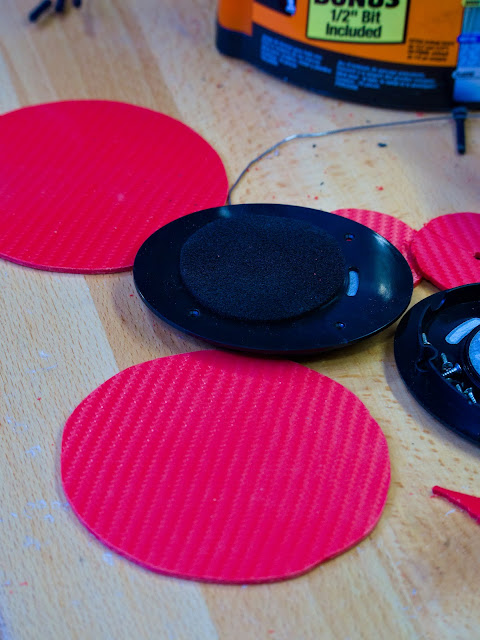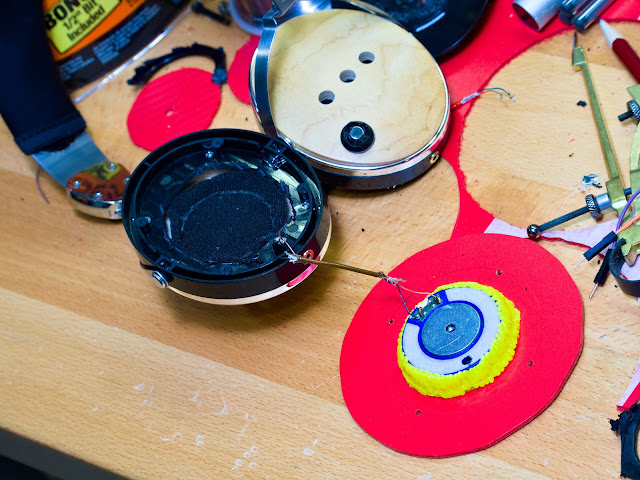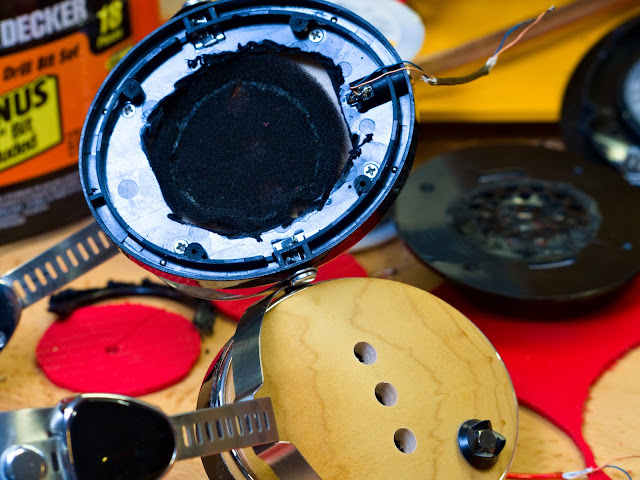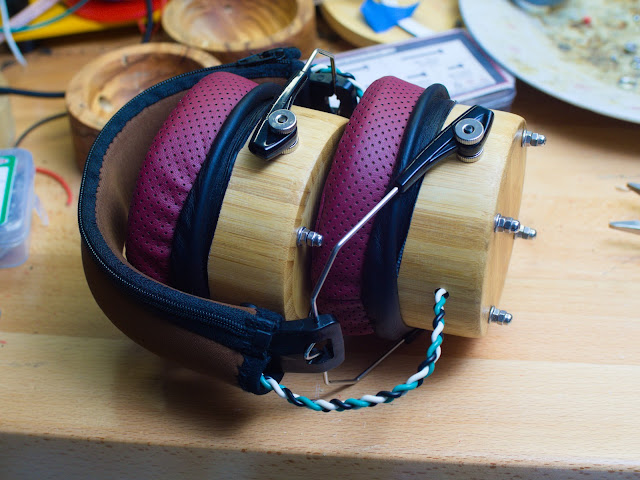Make what?
I decided to make my own headphones. I came across the drivers on ebay while looking for some replacement headphones. It seems in general - great sound, great build quality, low cost - pick any two.
I am not an audiophile, nor do I have high end audio gear. My main listening devices are my PC with a iFi Zen DAC. For exercise, I use my phone with a Qudelix-5K bluetooth DAC. These are easily adequate, but in no way represent "high end" audio equipment.
But...why make headphones?
I started to appreciate decent audio quality when my Razer Kraken died. I picked up a Philips Fidelio L2 and V-Moda cable+headset mic as a replacement. The Razer had extremely solid build quality. Good use of metal. I complained about the non-detachable cable as a weakness on their forum and a rep contacted me and even sent a replacement. I cannot fault their customer service.
The Philips however had wonderful clean tuning. Bass, mids and highs were all present. Nothing felt like it dipped too low. It was clearer than my Razer too. The build quality was OK. Lot of metal, but I think there's a couple weak points. I still have it, so it lasts. Comfort was missing in one area - the headband pressed in a small area at the top of my head. Why did it sound better? Driver? Pads? something about the way it let sound out with the semi-open nature?
So I looked around, adamant that I'll buy something more comfortable with good build quality after a particularly long call. The top of my head was smarting - I swear I could feel a dent 😛. I came across the Symphonized Wraith 2.0. It was relatively cheap, but used good materials. Metal brackets, headband. the extension mechanism was also metal. The cups used plastic and wood. It was comfortable to the top of my head, but had horrible pads. It didn't sound great.
By now I understood from numerous reviews and youtube research (that's a potentially painful phrase, but honestly makes more sense than it should) that I can change the sound with some mods. I bought a couple types of pads. Plain leather didn't sound much better, but the headphones at least weren't resting on my ears. The next up were fenestrated pads - pads with perforations. The sound had changed dramatically better. Probably still not as good as the Philips, but close. So much more comfortable though. If I were to guess, when the speaker diaphragm moves, it creates pressure changes. If air on either side of the diaphragm has nowhere to go, then the pressure builds up - between the speaker and headphone cup, or between the speaker and your ear. I believe the perforations on the fenestrated pad lets the air move more freely between the speaker and ear letting the diaphragm move easier.
IEMs were next!
In my quest for bang for buck audio, it was hard not to try some in-ear monitors. I.e. the little earphones that enter your ear canal.
- KZ zs10 pro - I was wowed by the sound and price. I picked this up because I needed a small headset to work with from my phone. This really surprised me. Strong bass, and good mids. Highs were nice - lower than others. This was good in a way - it gets tiresome listening to shrill noises after a while. It did lack detail though.
- Tin Audio T2 - The KZ brought a comfortable listening experience. The Tin Audio T2 brought more detail than I was accustomed to. The weak point here was a lack of lower bass. Everything was wonderfully detailed. This is considered a neutral sound from online reviews.
- Shuoer Tape - I had finally decided to spend a little more on these. When you're buying small IEMs, you think to yourself you shouldn't spend much on them, but it's really worth it. These had a nice bass kick and extreme detail. It's just really shrill at times. Some songs would feel harsh. This was somewhat mitigated by using Shure tips with a narrow opening, but this costs a little of that extreme detail.
- KZ ZSX - Can be uncomfortable, but a nice "v" shaped tuning that stresses the bass and elevates some highs. Details were probably not as good as the T2 and the mids weren't as well represented as the highs and bass, but this took my top spot for a time.
- Etymotic ER3XR - I bought these because it was on a really steep discount. Honestly one of the most detailed IEMs I've ever used, but it's too uncomfortable for me to appreciate it.
- Fiio FH3 - this is my current goto. This uses a beryllium plated diaphragm providing substantial bass. 2 Balanced armatures provide more mid/highs. Balanced armatures are quicker to react than a diaphragm, so they can provide more detail in general. A diaphragm moves more air, so it provides better bass normally. By coating the diaphragm in beryllium, it's stiffer and can react to the rapid movements of the coil better. The result isn't just good bass, but details that I wouldn't notice with anything but the Etymotic. These had a nice slight V shaped emphasis on the bass and treble.
By this point, my IEM's sound far surpassed my over-ear headphones. Over-ear does provide a nice feel to the music. Ever stand next to a speaker and feel the music with your body? An over-ear accomplishes this to a much smaller degree. You're not going to feel it on every song, but when you do (on your face not your body :P), you'll look at your stash of IEMs, and wistfully wish they could do this too. Instruments and sounds also seem to come from further away. This helps with interpreting where the sound is coming from. Finally I don't trust listening to music using IEMs constantly. I believe that being this close to my eardrum, it's more likely to affect my hearing. Yeah, something I noticed on these headphones forums was the number of people that would complain, question or meme about tinnitus.
Where am I going with this?
So after experiencing aural bliss with the FH3 but wishing it were over-ear, I figured it was time to make my own headphones. I had been seeing replacement drivers for several makes of headphones online - even higher end units like the titanium driver in the AKG 371. They weren't too expensive either. So well why not ¯\_(ツ)_/¯
The build!
I started with some Bamboo containers. These are meant to hold cooking spices. They were definitely too deep to use directly. I used a rotary cutting tool and my clamp as a jig to maintain a specific depth as I cut it down to size.
In the process, flaws in the bamboo container caused the bottom of one to fall out, and a split along the side. This was resolved with copious amounts of wood glue and a couple clamps. I ended up coating the insides of both cups hoping it would increase the strength of each.
Next up drilling holes. I cut out a cardboard circle with some holes as a template for where to drill. The same template was used to get holes made on plastic discs, cut to 107mm diameter. This size produced enough of a lip to squeeze 105/110mm pads over. Plastic used was kydex. It's tough and used in knife sheaths. I had olive wood cups I started working on as well as a secondary set.
The cups were sanded. The glued cup needed some in particular. 4 holes from back to front to clamp down the plastic disc to the bamboo cup. 2 on the sides which will bolt the cup to the headband. One on the top for the wires connecting left and right cups. One on the bottom for the female jack. I put a female jack on both cups - You can plug into either one, or even connect a second headphone. A light varnish coating was applied to protect the bamboo.
For the discs, my plan was the speaker would attach directly. For this, I traced out the speaker, and drilled 4 holes around the outline.
M2.5 screws and a small nut through each hole acted as anchors for the speaker. A 3d pen was used to "draw" the bracket in place around the speaker.
With the speaker secured, it's time to look at the grille. Here's a shot of that titanium goodness.
To connect the left and right cups, I needed 3 wires. I didn't have anything premade, so I sacrificed a power cable. Stripping away the outer insulation left the inner wires. I plaited the wires with the ends clamped. This way it would neatly carry the signal needed between the cups.
Here's a view of the cups wired to the jack. The black wire connects the central prong of the jack. The white and green connect to left and right prongs respectively. The red/black wires for each cup connect to white/black and green/black for the left and white cups. I mentioned using copious amounts of glue. Well, there you can see it. The red glop is liquid tape. It's convenient. Gets in there to cover the contacts so nothing accidentally shorts out the headphones.
Once the glue and goop are dry, it's time to add hardware, then foam. Foam dampens sound - absorbs the pressure wave, stopping sound from reflecting off the back of the cup. I'm using safety earmuffs for the headband, and it also comes with foam. These are cheap and quite sturdy, making this pretty effective.
Once the speakers were soldered to the red/black cables, I experimented with the screw/nut combination that would leave enough screw outside the cup to bolt on to the headband. I used 4 thumbscrews for each cup. On either side of the cup, one thumbscrew secured the bolt to the cup, and another tightened down on that. The narrow end of the thumbscrews formed a nice saddle for the headband to pivot off of. With that over, the foam can be stuffed in the cup.
Looking good so far. I kept testing the sound using a generic "left right speaker test" I searched for on youtube. I used 45mm screws to bolt the red plastic disks from before to the cup. The bolt held the speaker grille down against the disk as well. A non slip nut holds it from the other end, and this was topped off using an acorn nut to keep it smooth.
The final piece was the headband. The brackets were bolted to the cups already, so this part just snaps in place. I used a headband pad to pass the wire through and make it more presentable.
Here's a view on my head. The clamping pressure of the headband is higher than regular headphones. I'll be experimenting with a hot-air gun to see if I can make it a bit more relaxed. I'm really enjoying the sound though. Did I accomplish my goal? Maybe. It's definitely beyond my Philips and modified Symphonized headphones. Details are crystal clear, and I'll have to really compare my Fh3 closely to determine which one has more - so that is a big win already. I can hear positions better. Nothing is lacking, and treble isn't pressing into painful levels.
Some tracks I've been testing with.
- Massive Attack - "Angel" and "Teardrop". Bass heavy tracks. Test here is if it's substantial while providing detail.
- Ennio Morricone - "The Good, The Bad and The Ugly" soundtrack, "The Ecstasy of Gold" and "The Trio". This is my treble test. Both have points that can bring out painful shell noise, or smooth sweet highs. Note the vocals in "Ecstasy" and trumpet in "The Trio". If the female vocals aren't enough of a stress test for your earpiece, the trumpet may be. Playing those without painful shrill noise, but sweet highs is an accomplishment. There's a lot of instruments at the end of "Ecstasy" making it a decent test, being able to pick out the different instruments. A lot of potential there to produce a cacophony.
- Chuck Mangione - "Feels So Good", Dave Brubeck Quartet - "Take Five". Instrumental jazz provides solid range in tone and harmonics in the notes, testing range and clarity, instrument separation, position etc.
- My brother gave me this one. Alan Walker - "Faded". Listen for the seagulls at the start and end. Decent test for sensitivity and detail.


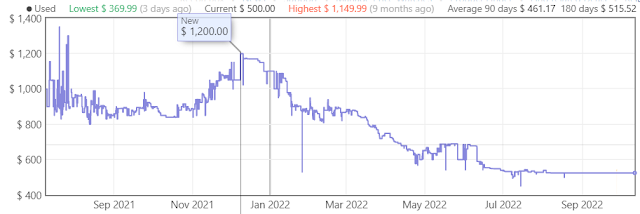


.jpg)



